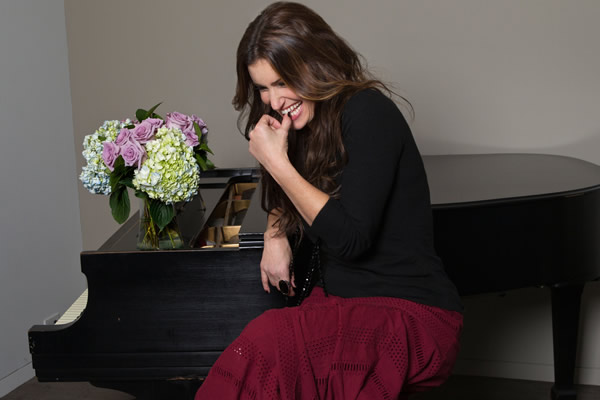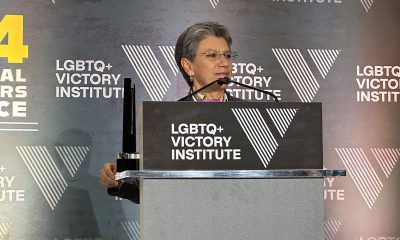Arts & Entertainment
Menzel’s magic
Broadway powerhouse brings summer tour to Wolf Trap next week


Singer Idina Menzel balances motherhood, touring, Broadway and Hollywood in a busy career but says she enjoys the concerts most. (Photo courtesy Concord Music Group)
‘An Evening with Idina Menzel’
Aug. 3, 8:15 p.m.
Wolf Trap Filene Center
1551 Trap Rd.
Vienna, VA
Tickets range from $20 (lawn) to $100 (orchestra pit)
Idinamenzel.com
Pretty much any veteran live performer will say they have some little personal “trick” they use to keep their most oft-performed material fresh. For Idina Menzel and her trademark “Wicked” showstopper “Defying Gravity,” it’s sometimes a gay teen — perhaps with a little projecting — that helps get her through the song.
Well, that and what she describes as kind of obligation she has to the star-making material.
“That song is a personal gift to me,” she says. “I have a personal debt I owe to that music. Because I have to sing it so much, people ask if it gets monotonous. I can truthfully say that doesn’t happen because every time I sing it, I come from a different place. It could be the young 14-year-old boy in the front row singing it along with me who may not have come out yet. I know how much the song means to him, so I can sing it to him that night. I think it’s a testament to how well written a song it is that it can speak to so many different people.”
Menzel brings her summer tour to Wolf Trap next week for her only D.C.-area appearance. The Tony winner, who’s become a household name since she debuted in “Rent” in 1996 and later in “Wicked” in 2003, also varies her set list slightly from city to city, another show-freshening trick she swears by. She’ll perform in Virginia with the National Symphony Orchestra under the direction of Steven Reineke.
“I’m excited about the show not only because of the material I’m doing, but because I feel like I’ve found a way to make every city have a show that’s unique to them,” Menzel, 41, says. “People should know when they come to see the show they can leave feeling like they got to know a little piece of who I am and it’s not the same everywhere. Every city’s just a little bit different.”
“I’ve been doing it with the symphony for almost three years already, which I truly love. It’s been a wonderful experience for me, which is why I continue to do it,” Menzel says. “There’s an intimacy I’m able to maintain even though I have all these musicians behind me. I had to strike a balance with it early on. It was a little bit of work for me to figure out how to do that, but now it’s pretty natural and organic.”
Even after appearing in two seasons of “Glee” and in films like “Rent” and Disney’s “Enchanted,” Menzel still finds singing live to be her favorite brand of performance.
“I definitely thrive off of the live audience and the adrenaline of being in the moment,” she says.
In 2009, Menzel had her first child, son Walker, with fellow Broadway actor and husband Taye Diggs. Before motherhood, Menzel had a strict regimen for keeping her vocals up, but now being more flexible with her schedule as a mother has only enhanced her performance experiences, she says.
“The more I sing the better for me. I’m like a marathon runner as far as running everyday. So that’s kind of how I approach it — athletically. And I’m just finding that being a mom and having a little boy now has changed my whole perspective on that. I used to have such a ritual and routine that I still try to keep, but if I deviate from it I’m a little less hard on myself, and in return I feel like the rewards are greater for me professionally. I may not be as prepared vocally, but then I’m on stage and I feel more free.”
Menzel’s summer tour includes old favorites from her roles on Broadway in “Wicked” and “Rent,” as well as other hits featured in her concert “Barefoot at the Symphony” that aired on PBS and has now been released on DVD.
“There are a few songs I wouldn’t leave stage without singing. I’m constantly changing [the set list], trying to tell different stories,” Menzel says. “It’s half and half music people would expect and the other stuff is new stuff I want to challenge myself with.”
Looking back, Menzel finds that she was in very different places in life during her appearances on “Glee” in the show’s first and third seasons. She was still adjusting to being a mom while filming the first season, but during the filming of the third season was more used to juggling parenthood and her career.
“The last season I was on I enjoyed it a lot more. I was learning how to balance motherhood and work for myself. I was enjoying the cast and I didn’t have to run home every second to pump my boobs or whatever,” Menzel says. “I hope [the cast] are all really appreciating it and enjoying it in the moment because you can easily lose sight of how incredible it is. I would love to do more TV, but my definitive wish was to get back to New York and do another show.”
In addition to touring, Menzel is working on a number of projects. She’s working alongside composers of original pieces for new musicals to act as a “muse,” singing and doing readings of their work so they can hear the results of their writing. She’s also thrilled to start work as Elsa in a new Disney movie called “Frozen” set for release in 2013.
“It’s amazing for me, like a dream,” she says. “It’s an animated Disney movie and there’s lots of music in it. It’s a beautiful story, and we just got started.”
And yes, as clichéd as it might sound for a Broadway powerhouse, Menzel is aware and appreciative of her gay following.
“I did the Atlantis cruise ship with 1,000 gay men and I had probably the greatest time I’ve ever had,” she says.
Though on one hand she says it makes no difference — “an audience is an audience, made up of all different kinds of people” — she says the gay kids who tell her “Wicked” helped them come out mean a lot.
“All that kind of stuff is part of the benefits I reap from what I do for a living. It enriches me as a person and I feel like everyone’s in it together out there.”
Gay conductor to lead NSO for Menzel show
By BRIAN T. CARNEY
Maestro Steven Reineke says his friend Idina Menzel wouldn’t want him to say too much about what she’ll be singing at their upcoming performance with the National Symphony Orchestra at Wolf Trap.
But he does mention, “She covers a lot of material in her set. And she tells great stories. She’s very interactive with the audience. There’s even some audience participation.”
He’s more forthcoming about the first half of the program, which will start with one of his own compositions. The gay composer and conductor wrote “Celebration Fanfare” when he was 25 (he turns 42 in September) and notes that the piece is still performed frequently by orchestras and concert bands across the country. The work is dedicated to Erich Kunzel, conductor of the Cincinnati Pops, who served as a mentor to Reineke and encouraged his career as both composer and conductor.
Reineke resisted the temptation to start the evening with his own version of “Defying Gravity,” though Reineke’s piece was written to celebrate another kind of flight — the centennial of the Wright Brother flight. He says it’s a funny coincidence that Broadway composer Stephen Schwartz used the same title for the Act I finale of “Wicked,” a number that has become a signature piece for Menzel.
“We just happened to come up with the same title. They have nothing to do with each other whatsoever,” he says.
Reineke started composing when he was a teenager. He remembers, “I had all this music running around my head. I started to plunk things out on the piano because I just needed to get these songs out. It wasn’t really a conscious choice.”
It was also about that time he realized he was gay.
”I came out to myself when I was 17 years old, a senior in high school getting ready to go off to college. I’ll never forget having that cathartic moment when I stared in the mirror and said the words out loud, ‘I am gay.’ That was the hardest part about the process.”
As he began his professional life, Reineke remained open about his sexuality and says it was “a no brainer” because “I was never really in. The more notoriety I got, the more it came up, and I’m just not the kind of person to deny it. I just treat it as a very normal part of life. There was no big coming out.”
Reineke isn’t sure why the “classical closet” (cultural critic K. Robert Schwarz’s term for the dearth of classical musicians who are openly LGBT) still persists so strongly. He does note, “I do wish that more people would treat is as a non-issue, whether they’re in the arts, or sports figures, or television or whatever.”
Staying in the closet, he says, only perpetuates myths.
“That’s one thing that keeps the stigma about it. People staying buried instead of saying, ‘Here I am, deal with it.’”
His sexuality has not played a major role in his musical career. As a composer, he often takes his cue from the visual and visceral imagery he finds in mythology and nature. Reineke, who initially wanted to be a film composer, says he needs a visual image in mind before he starts composing: “Basically I’m creating a soundtrack to my own movie in my own head.”
As a conductor and music director (he’s also music director of the New York Pops and the principal pops conductor for the Toronto Symphony Orchestra and the National Symphony Orchestra here in Washington), Reineke says his focus is on the audience and the musicians.
“I have no particular agenda other than the health and success of the orchestra and the good times had by an audience.”

A protest was held outside of the White House on Saturday following the killing of Renee Nicole Good by a U.S. Immigration and Customs Enforcement agent in Minneapolis. Across the Potomac, picketers held signs calling for “Justice for Renee” in Tysons, Va.
Demonstrations were held in cities and towns across the country, according to multiple reports. A march was held yesterday in Washington, D.C., as the Blade reported. Further demonstrations are planned for tomorrow.
(Washington Blade photos by Michael Key)









Books
Feminist fiction fans will love ‘Bog Queen’
A wonderful tale of druids, warriors, scheming kings, and a scientist

‘Bog Queen’
By Anna North
c.2025, Bloomsbury
$28.99/288 pages
Consider: lost and found.
The first one is miserable – whatever you need or want is gone, maybe for good. The second one can be joyful, a celebration of great relief and a reminder to look in the same spot next time you need that which you first lost. Loss hurts. But as in the new novel, “Bog Queen” by Anna North, discovery isn’t always without pain.

He’d always stuck to the story.
In 1961, or so he claimed, Isabel Navarro argued with her husband, as they had many times. At one point, she stalked out. Done. Gone, but there was always doubt – and now it seemed he’d been lying for decades: when peat cutters discovered the body of a young woman near his home in northwest England, Navarro finally admitted that he’d killed Isabel and dumped her corpse into a bog.
Officials prepared to charge him.
But again, that doubt. The body, as forensic anthropologist Agnes Lundstrom discovered rather quickly, was not that of Isabel. This bog woman had nearly healed wounds and her head showed old skull fractures. Her skin glowed yellow from decaying moss that her body had steeped in. No, the corpse in the bog was not from a half-century ago.
She was roughly 2,000 years old.
But who was the woman from the bog? Knowing more about her would’ve been a nice distraction for Agnes; she’d left America to move to England, left her father and a man she might have loved once, with the hope that her life could be different. She disliked solitude but she felt awkward around people, including the environmental activists, politicians, and others surrounding the discovery of the Iron Age corpse.
Was the woman beloved? Agnes could tell that she’d obviously been well cared-for, and relatively healthy despite the injuries she’d sustained. If there were any artifacts left in the bog, Agnes would have the answers she wanted. If only Isabel’s family, the activists, and authorities could come together and grant her more time.
Fortunately, that’s what you get inside “Bog Queen”: time, spanning from the Iron Age and the story of a young, inexperienced druid who’s hoping to forge ties with a southern kingdom; to 2018, the year in which the modern portion of this book is set.
Yes, you get both.
Yes, you’ll devour them.
Taking parts of a true story, author Anna North spins a wonderful tale of druids, vengeful warriors, scheming kings, and a scientist who’s as much of a genius as she is a nerd. The tale of the two women swings back and forth between chapters and eras, mixed with female strength and twenty-first century concerns. Even better, these perfectly mixed parts are occasionally joined by a third entity that adds a delicious note of darkness, as if whatever happens can be erased in a moment.
Nah, don’t even think about resisting.
If you’re a fan of feminist fiction, science, or novels featuring kings, druids, and Celtic history, don’t wait. “Bog Queen” is your book. Look. You’ll be glad you found it.
Movies
A Shakespearean tragedy comes to life in exquisite ‘Hamnet’
Chloe Zhao’s devastating movie a touchstone for the ages

For every person who adores Shakespeare, there are probably a dozen more who wonder why.
We get it; his plays and poems, composed in a past when the predominant worldview was built around beliefs and ideologies that now feel as antiquated as the blend of poetry and prose in which he wrote them, can easily feel tied to social mores that are in direct opposition to our own, often reflecting the classist, sexist, and racist patriarchal dogma that continues to plague our world today. Why, then, should we still be so enthralled with him?
The answer to that question might be more eloquently expressed by Chloe Zhao’s “Hamnet” – now in wide release and already a winner in this year’s barely begun awards season – than through any explanation we could offer.
Adapted from the novel by Maggie O’Farrell (who co-wrote the screenplay with Zhao), it focuses its narrative on the relationship between Will Shakespeare (Paul Mescal) and his wife Agnes Hathaway (Jessie Buckley), who meet when the future playwright – working to pay off a debt for his abusive father – is still just a tutor helping the children of well-to-do families learn Latin. Enamored from afar at first sight, he woos his way into her life, and, convincing both of their families to approve the match (after she becomes pregnant with their first child), becomes her husband. More children follow – including Hamnet (Jacobi Jupe), a “surprise” twin boy to their second daughter – but, recognizing Will’s passion for writing and his frustration at being unable to follow it, Agnes encourages him to travel to London in order to immerse himself in his ambitions.
As the years go by, Agnes – aided by her mother-in-law (Emily Watson) and guided by the nature-centric pagan wisdom of her own deceased mother – raises the children while her husband, miles away, builds a successful career as the city’s most popular playwright. But when an outbreak of bubonic plague results in the death of 11-year-old Hamnet in Will’s absence, an emotional wedge is driven between them – especially when Agnes receives word that her husband’s latest play, titled “Hamlet,” an interchangeable equivalent to the name of their dead son, is about to debut on the London stage.
There is nothing, save the bare details of circumstance around the Shakespeare family, that can be called factual about the narrative told in “Hamnet.” Records of Shakespeare’s private life are sparse and short on context, largely limited to civic notations of fact – birth, marriage, and death announcements, legal documents, and other general records – that leave plenty of space in which to speculate about the personal nuance such mundane details might imply. What is known is that the Shakespeares lost their son, probably to plague, and that “Hamlet” – a play dominated by expressions of grief and existential musings about life and death – was written over the course of the next five years. Shakespearean scholars have filled in the blanks, and it’s hard to argue with their assumptions about the influence young Hamnet’s tragic death likely had over the creation of his father’s masterwork. What human being would not be haunted by such an event, and how could any artist could avoid channeling its impact into their work, not just for a time but for forever after?
In their screenplay, O’Farrell and Zhao imagine an Agnes Shakespeare (most records refer to her as “Anne” but her father’s will uses the name “Agnes”) who stands apart from the conventions of her town, born of a “wild woman” in the woods and raised in ancient traditions of mysticism and nature magic before being adopted into her well-off family, who presents a worthy match and an intellectual equal for the brilliantly passionate creator responsible for some of Western Civilization’s most enduring tales. They imagine a courtship that would have defied the customs of the time and a relationship that feels almost modern, grounded in a love and mutual respect that’s a far cry from most popular notions of what a 16th-century marriage might look like. More than that, they imagine that the devastating loss of a child – even in a time when the mortality rate for children was high – might create a rift between two parents who can only process their grief alone. And despite the fact that almost none of what O’Farrell and Zhao present to us can be seen, at best, as anything other than informed speculation, it all feels devastatingly true.
That’s the quality that “Hamnet” shares with the ever-popular Will Shakespeare; though it takes us into a past that feels as alien to us as if it took place upon a different planet, it evokes a connection to the simple experience of being human, which cuts through the differences in context. Just as the kings, heroes, and fools of Shakespeare’s plays express and embody the same emotional experiences that shape our own mundane modern lives, the film’s portrayal of these two real-life people torn apart by personal tragedy speaks directly to our own shared sense of loss – and it does so with an eloquence that, like Shakespeare’s, emerges from the story to make it feel as palpable as if their grief was our own.
Yes, the writing and direction – each bringing a powerfully feminine “voice” to the story – are key to the emotional impact of “Hamnet,” but it’s the performances of its stars that carry it to us. Mescal, once more proving himself a master at embodying the kind of vulnerable masculine tenderness that’s capable of melting our hearts, gives us an accessible Shakespeare, driven perhaps by a spark of genius yet deeply grounded in the tangible humanity that underscores the “everyman” sensibility that informs the man’s plays. But it’s Buckley’s movie, by a wide margin, and her bold, fierce, and deeply affecting performance gives voice to a powerful grief, a cry against the injustice and cruelty of what we fumblingly call “fate” that resonates deep within us and carries our own grief, over losses we’ve had and losses we know are yet to come, along with her on the journey to catharsis.
That’s the word – “catharsis” – that defines why Shakespeare (and by extension, “Hamnet”) still holds such power over the imagination of our human race all these centuries later. The circumstantial details of his stories, wrapped up in ancient ideologies that still haunt our cultural imagination, fall away in the face of the raw expression of humanity to which his characters give voice. When Hamlet asks “to be or not to be?,” he is not an old-world Danish Prince contemplating revenge against a traitor who murdered his father; he is Shakespeare himself, pondering the essential mystery of life and death, and he is us, too.
Likewise, the Agnes Shakespeare of “Hamnet” (masterfully enacted by Buckley) embodies all our own sorrows – past and future, real and imagined – and connects them to the well of human emotion from which we all must drink; it’s more powerful than we expect, and more cleansing than we imagine, and it makes Zhao’s exquisitely devastating movie into a touchstone for the ages.
We can’t presume to speak for Shakespeare, but we are pretty sure he would be pleased.
-

 National4 days ago
National4 days agoWhat to watch for in 2026: midterms, Supreme Court, and more
-

 Opinions5 days ago
Opinions5 days agoA reminder that Jan. 6 was ‘textbook terrorism’
-

 Colombia5 days ago
Colombia5 days agoClaudia López criticizes Trump over threats against Colombian president
-

 District of Columbia4 days ago
District of Columbia4 days agoImperial Court of Washington drag group has ‘dissolved’





















